Last week, we started sending a new weekly “Six Feet in Solidarity” email. Through this series we’re sharing online resources and opportunities to build your water knowledge around different topics for as long as social distancing lasts.
It’s our way of staying connected and being of service to the greatest extent possible during this unprecedented time.
We’ll be pulling from our library of publications, news stories, webinars, videos, radio programs, and more, and also sharing key resources produced by others in the water community. If you have ideas, please share at info@wateredco.org.
We started off with an email focused on land use and water (if you missed it, find it here). This week we’ll take a look at stream management plans in Colorado. Read on to learn more. And be well!
What Does a Stream Need?

Friends of the Yampa board members and members stand in Juniper Canyon, scouting the Maybell Irrigation Ditch, a diversion that takes water off the Yampa River into the Maybell Valley west of Craig. Photo courtesy of Friends of the Yampa by Kent Vertrees.
Many Colorado communities and watersheds are collecting data and taking action to improve the health of the state’s rivers and, in places, to sustain recreation. Others are also collecting social data on water users’ goals. Spurred by an infusion of state funding, now a few years in the making, Colorado coalitions, towns, and entire basins are making progress on creating and implementing local stream and water management plans that focus on the lifeblood of any community—the river.
The Colorado Water Plan, published in 2015, raised the bar for the state’s rivers and streams by assigning equal importance to all of the state’s key values—municipal, industrial, agricultural, environmental and recreational. That document also calls for local communities to develop plans that are specific to their streams: By 2030, it calls for 80 percent of the state’s locally prioritized rivers to be covered by stream management plans. Read the Environmental and Recreational Projects and Methods chapter of the water plan, chapter 6.6, and find information on stream management plans beginning on page 6-168.
No time like the present to focus on streams

(From “Best-Laid Plans” in our Summer 2018 issue of Headwaters magazine):
Colorado is in the midst of a veritable stream management planning boom—one triggered, in large part, by the Colorado Water Plan. Two primary types of plans are emerging across the state—stream management plans and integrated water management plans. Stream management plans address environmental needs and recreational goals. Using scientific assessments to measure the ecological health of a particular stretch of water, these plans help communities figure out where and how their waterways are impaired, with a focus on streamflows, so they can develop strategies to preserve or improve their environmental and recreational assets. Integrated water management plans go one step further to factor in consumptive uses from the municipal, agricultural and industrial sectors.
What parts of Colorado are already covered or working on stream management plans?
Quite a few! Visit coloradosmp.org for an interactive map, list, and summaries of many completed and in-progress plans.
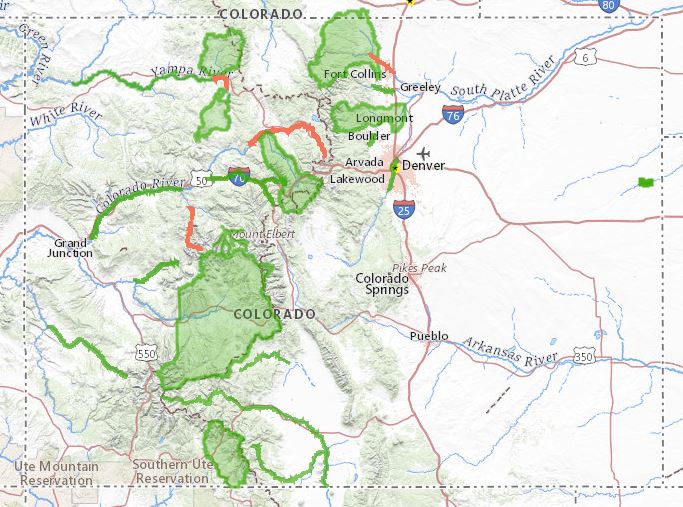
Fresh Water News: Can a reforestation effort along the Yampa River relieve high-temperature streamflows?
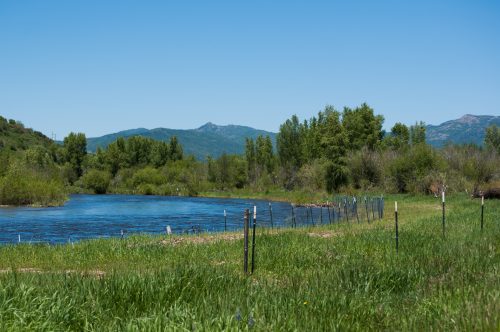
The City of Steamboat Springs has been implementing its stream management plan, which was completed in June 2018 on a 12.5-mile stretch of the Yampa River through town.
On this stretch of the river, in recent years, warm summer months have caused such high spikes that recreational access to the Yampa River has been closed in order to protect the fish and wildlife that depend on colder waters.
The plan recommended actions to cool the river’s flows, such as establishing riparian vegetation like cottonwood trees to increase shading on the river. Could something as simple and natural as a ragged corridor of expansive, towering shade trees help a river arm itself against a world in which temperatures are rising? A 300-person-strong army of volunteers is banking on it through its ReTree program, initiated last year.
Read our Fresh Water News coverage of the story here.
New film series features the Yampa River’s ReTree program
Watch this video, produced through Fresh Water News’ partnership with PBS’ This American Land, and join us as we meet the community members who are working to improve water quality on the Yampa River through the ReTree effort.
What is the role of agriculture in stream management plans?
From the Colorado Ag Water Alliance: The agricultural community is a critical watershed stakeholder in these processes. Often they own a majority of the water rights in an area and agricultural activity provides valuable jobs, habitat, open space, and food for the wider community. A viable Stream Management Plan needs to recognize these values. Benefits to the agricultural community can provide further benefits to environmental and recreational stakeholders.
The Colorado Ag Water Alliance has been producing videos and fact sheets on planning efforts that have been beneficial to ag water users. Find them on their website or click through the videos below:
Middle Colorado Ditch Inventory
Rio Grande Five Ditches Project
Left Hand Creek
Mancos River
More Resources from WEco on Stream Management Plans
Webinar: From Planning to Implementation: Steamboat Springs’ Stream Management Plan
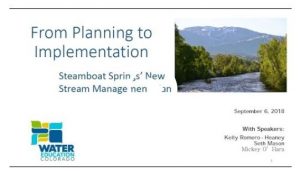 Aired September 6, 2018 – When Steamboat Springs initiated work on its stream management plan, stakeholders sought to understand how river flows were affecting water temperature. Now that the city has its stream management plan in hand, this webinar explores its planning process. Learn how science and local priorities led to recommendations in the plan, what a completed plan means for existing flow agreements, and how implementation might look going forward. Watch it here.
Aired September 6, 2018 – When Steamboat Springs initiated work on its stream management plan, stakeholders sought to understand how river flows were affecting water temperature. Now that the city has its stream management plan in hand, this webinar explores its planning process. Learn how science and local priorities led to recommendations in the plan, what a completed plan means for existing flow agreements, and how implementation might look going forward. Watch it here.
Radio: Stream Management Intersects with Flood Recovery on the St. Vrain
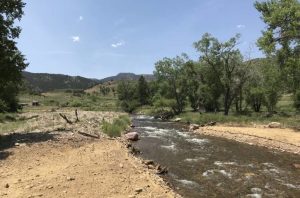 For the St. Vrain River in Colorado’s northern Front Range, stream management is intersecting with stream restoration from the floods of 2013. Listen to the radio story produced in June 2018 through Connecting the Drops, our partnership with Rocky Mountain Community Radio stations.
For the St. Vrain River in Colorado’s northern Front Range, stream management is intersecting with stream restoration from the floods of 2013. Listen to the radio story produced in June 2018 through Connecting the Drops, our partnership with Rocky Mountain Community Radio stations.
Headwaters Magazine: What Does A Stream Need?
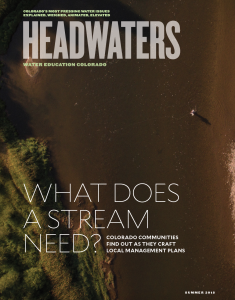 Read this summer 2018 issue of Headwaters to read more about stream management planning, integrated water management planning, groups and plans making progress in Colorado, and resources to support them.
Read this summer 2018 issue of Headwaters to read more about stream management planning, integrated water management planning, groups and plans making progress in Colorado, and resources to support them.
More Resources from Other Organizations
Stream Management Plan Resource Library
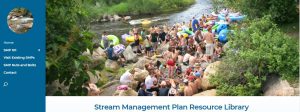 Are you interested in learning about Stream Management Plans (SMP) in Colorado? This Resource Library, from the Colorado Water Conservation Board and the River Network, contains everything you need to understand what they are, where they are, how they can be used, and how to do them well. Visit coloradosmp.org for a plethora of up-to-date information on stream management plans in Colorado.
Are you interested in learning about Stream Management Plans (SMP) in Colorado? This Resource Library, from the Colorado Water Conservation Board and the River Network, contains everything you need to understand what they are, where they are, how they can be used, and how to do them well. Visit coloradosmp.org for a plethora of up-to-date information on stream management plans in Colorado.
Colorado Basin Roundtable Integrated Water Management Planning Framework Project
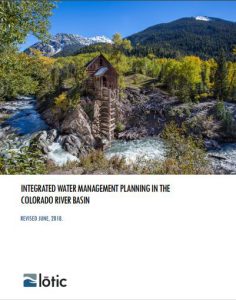 The Colorado Basin Roundtable’s Integrated Water Management Planning Framework Project created guidance and online data tools to build a foundation for conducting comprehensive integrated water management plans in the mainstem Colorado River Basin in Colorado. The purpose of these plans is to identify ways to provide water for environmental needs in conjunction with the needs of agricultural, domestic and industrial water users. Find resources, here.
The Colorado Basin Roundtable’s Integrated Water Management Planning Framework Project created guidance and online data tools to build a foundation for conducting comprehensive integrated water management plans in the mainstem Colorado River Basin in Colorado. The purpose of these plans is to identify ways to provide water for environmental needs in conjunction with the needs of agricultural, domestic and industrial water users. Find resources, here.
Reaching Higher: September 2016 issue of Colorado Water
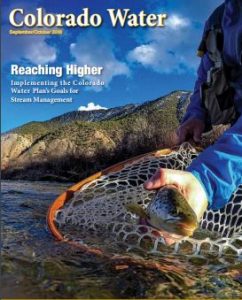 This issue of Colorado Water, from the Colorado Water Center out of Colorado State University, looks at implementing the Colorado Water Plan’s Goals for stream management plans. Read it here.
This issue of Colorado Water, from the Colorado Water Center out of Colorado State University, looks at implementing the Colorado Water Plan’s Goals for stream management plans. Read it here.
The Colorado Water Plan
 The water plan set goals for stream management planning and also better defined goals of planning and different approaches for considering watershed health. Visit section 7.1, Watershed Health and Management; and section 6.6, Environmental and Recreational Projects and Methods.
The water plan set goals for stream management planning and also better defined goals of planning and different approaches for considering watershed health. Visit section 7.1, Watershed Health and Management; and section 6.6, Environmental and Recreational Projects and Methods.


 Print
Print